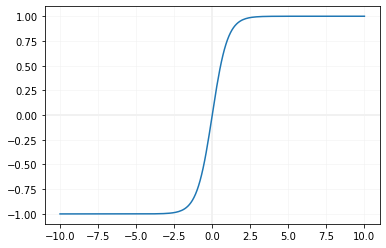tanh()
import math
print(math.tanh(-5)) # -0.9999092042625951
print(math.tanh(-1)) # -0.7615941559557649
print(math.tanh(-0.9)) # -0.7162978701990244
print(math.tanh(0)) # 0.0
print(math.tanh(0.9)) # 0.7162978701990244
print(math.tanh(1)) # 0.7615941559557649
print(math.tanh(5)) # 0.9999092042625951Inputs in degree
We can convert radian value to degree and use the sameimport math
in_degree = 50
in_redian = math.radians(in_degree)
print(math.tanh(in_redian)) # 0.7027254303610717 1 radian = 57.2957914331 degree
1 degree = 0.0174533 radian
1 degree = 0.0174533 radian
Drawing graph of tanh()
We will use Matplotlib to generate graph of tanh
import matplotlib.pyplot as plt
x=[]
y=[]
i=-10
while (i<=10):
x.append(i)
y.append(math.tanh(i))
i=i+0.1
plt.plot(x,y)
plt.axvline(x=0.00,linewidth=2, color='#f1f1f1')
plt.axhline(y=0.00,linewidth=2, color='#f1f1f1')
plt.grid(linestyle='-',
linewidth=0.5,color='#f1f1f1')
plt.show()Example 1: Using tanh() as an Activation Function
import math
inputs = [-2, -1, 0, 1, 2]
outputs = [math.tanh(x) for x in inputs]
print(outputs) # Outputs between -1 and 1Example 2: Using cmath.tanh() for Complex Numbers
import cmath
z = 2 + 3j
print(cmath.tanh(z)) # Outputs tanh for a complex number(0.965385879022133-0.009884375038322495j)Example 3: Comparing tanh() with sinh() and cosh()
import math
x = 1.0
tanh_val = math.tanh(x)
sinh_cosh_val = math.sinh(x) / math.cosh(x)
print(f"tanh(1.0) = {tanh_val}")
print(f"sinh(1.0) / cosh(1.0) = {sinh_cosh_val}")tanh(1.0) = 0.7615941559557649
sinh(1.0) / cosh(1.0) = 0.7615941559557649Example 4: Limiting Hyperbolic Tangent Output
import math
x = 100 # Large input
print(math.tanh(x)) # Output will approach 1 as x increases
print(math.tanh(-100)) # Output will approach -1 as x decreasesExample 5: Using tanh() in a Mathematical Expression
import math
x = 0.5
y = 2.0
result = 3 * math.tanh(x) + 2 * math.tanh(y)
print(result) # output: 3.314406631931663
Subhendu Mohapatra
Author
🎥 Join me live on YouTubePassionate about coding and teaching, I publish practical tutorials on PHP, Python, JavaScript, SQL, and web development. My goal is to make learning simple, engaging, and project‑oriented with real examples and source code.
Subscribe to our YouTube Channel here
This article is written by plus2net.com team.
https://www.plus2net.com

 Python Video Tutorials
Python Video Tutorials